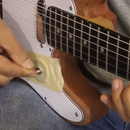Introduction: Arduino Strain Relief Enclosure
Arduino boards are great for experimentation. You just plug the wires in, and the connections stay there with spring force. On the other hand, they also pull out quite easily, so I developed an Arduino Uno enclosure that when the lid is tightened, it also tightens down the wires going into the board, locking them down and providing a good amount of strain relief.
Step 1: Materials Required
- 3/4 inch thick MDF
- (4) 4-40 screws
- 1/8 inch thick polycarbonate
- CNA - Super Glue
- Spray Paint
- Arduino Uno or Clone
Step 2: Cut Out MDF and Deburr Corners
As shown in the video, the base of this is made out of 3/4 inch MDF. Set up your CNC router to cut out the pattern shown in the included DXF, then cut out the corners with a Dremel tool or similar.
Alternatively, you could add the proper undercuts to the drawing, or even set it up to 3D print if you so desire.
Attachments
Step 3: Polycarbonate Top and Drill
Cut out the polycarbonate top on a CNC router. Once this is done, align cover on top of MDF base, and drill pilot holes for 4-40 screws as shown. Properly align the reset button before drilling to avoid any reassembly issues.
Enlarge holes (over .112 diameter) in the polycarbonate cover so that the screws can slide freely in and out.
Step 4: Tap Holes
Add CNA glue to each MDF hole in order to reinforce them and allow to dry. Tap each hole with a 4-40 tap.
Step 5: Paint
Spray paint as desired.
Or don't. It's your world.
Step 6: Assemble and Use
You now have an Arduino enclosure that you can not only see into, but locks down the wires coming out of your Arduino Uno. When tightened, this allows the wires some measure of protection from pulling out, and as seen in the video, it works will enough to support the Arduino board along with the enclosure.








![Tim's Mechanical Spider Leg [LU9685-20CU]](https://content.instructables.com/FFB/5R4I/LVKZ6G6R/FFB5R4ILVKZ6G6R.png?auto=webp&crop=1.2%3A1&frame=1&width=306)





